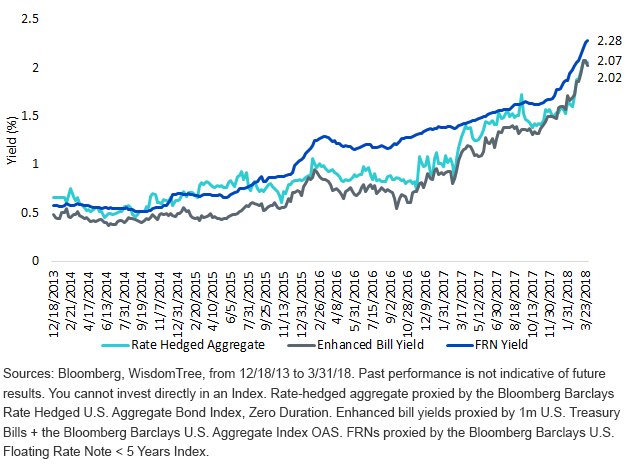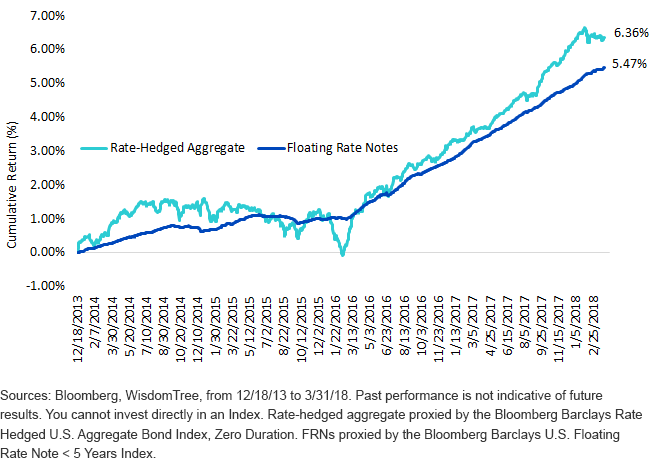Looking Under the Hood of Rate-Hedged Agg


In 2013, WisdomTree created a suite of interest rate-hedged fixed income strategies to help investors navigate rising rates. While the path to higher rates has not been a straight line, we believe rates remain biased to the upside in the medium term. While many U.S. investors were previously unfamiliar with the concept of currency hedging, WisdomTree’s approaches provided a powerful tool to isolate returns from equities from the impact of fluctuations in currencies. In fixed income, we believe a rate-hedged portfolio can allow investors to target a specific duration profile. Below, we seek to explain the drivers of return in a rate-hedged position and also contrast it to floating rate notes (FRNs), a traditional approach investors use to combat rising rates.
Constructing Rate-Hedged Portfolios
In our rate-hedged strategies, investors should think about the exposure as two portfolios. The first is long a basket of bonds that represent the Bloomberg Barclays U.S. Aggregate Index (Agg). The second portfolio seeks to identify the key interest rate exposures across the yield curve and then sell an offsetting position to hedge out interest rate risk. With a perfect hedge, any losses from rising rates in the long portfolio would be offset by gains in the short portfolio. However, since we’re short fixed income securities, there is a cost associated with this hedge. In our research, we found that this type of hedged portfolio had a very similar risk/return profile to a floating rate bond.
Where Are Rate-Hedged Returns Coming From?
When the strategy launched, a few people sought to model these returns and explain that there was no free lunch and to expect returns close to cash. We disagree that there is no return potential there. If an investor is long a cash bond and simultaneously short via a position in futures (assuming a perfect hedge1), you would expect that position to have a total return equal to the cash rate. The rationale is that instead of using cash to buy an asset, then simultaneously selling it at some point in the future at a price determined today, you could simply invest in t-bills and derive the same return. If this is not the case, then an arbitrage condition could exist.
Understanding Yields
Below, we contrast the net yields of three similar assets: the rate-hedged aggregate2, an “enhanced” cash position3 and floating rate corporate bonds4. While the sector weights of the aggregate fluctuate over time, they are generally a mix of investment-grade bonds (Treasuries, corporates, mortgages, securitized products).
Since investors need to be compensated for bearing risk, the yields in excess of what a similar-maturity Treasury bond pays can be represented by the option-adjusted spread (OAS). Therefore, the net yield of the rate-hedged aggregate should include compensation from the short-term cash rate and the spread between risky and riskless bonds.5
In the enhanced cash position, we combine one-month U.S. t-bills and the OAS of the Agg. As we show below, the net yields of both approaches appear quite similar. Finally, the yield on floating rate notes comprises the credit spread for lending to risky borrowers and a floating rate of interest. Given that these floating rate notes are all corporate bonds, they will generally have a larger total spread than the Agg. Also, given that floating rate notes have a duration equal to the amount of time until the next reset, floating rate notes have approximately 0.16 years of duration.6
Net Yield to Worst: Rate-Hedged Aggregate vs. FRN vs. Enhanced Bill Yields

Contrasting Returns
The interesting part of this analysis occurs when we contrast the returns of the floating rate notes and the rate-hedged aggregate. Despite having a lower net yield, the rate-hedged aggregate has outperformed FRNs by nearly 1% since the Fed began to taper its balance sheet at the end of 2013. This can primarily be explained by shifts in the yield curve combined with compensation for bearing the risk of an imperfect hedge.
The most dramatic deviation between rate-hedged aggregate returns and FRNs occurred in early 2016. This coincided with a dramatic spike in market volatility combined with a rapid decline in nominal interest rates. In fact, the 2-Year Treasury yield fell from 1.09% to 0.64% in two months. This rapid shift lower in yields led to a temporary drawdown for the strategy of nearly 1% due to the hedge mismatches in the strategy. As these temporary dislocations corrected, the strategy moved back in line. In our view, the higher returns generated by the rate-hedged aggregate with marginally higher volatility seems reasonable.
Cumulative Return: Rate-Hedged Aggregate vs. FRN

Conclusion
When WisdomTree sought to create our rising rates suite, we thought a more intuitive approach to managing risk was to maintain existing exposures like the Agg but then hedge out the risks that investors were concerned about. While there are no guarantees that our rate-hedged aggregate strategy will always outperform traditional approaches like floating rate notes, we believe the zero duration indexes can be powerful tools for investors to deploy as rates continue to rise in the U.S.
1We knowingly ignore the complexities of bond basis trading for this blog post.
2Proxied by the Bloomberg Barclays Rate Hedged U.S. Aggregate Bond Index, Zero Duration.
3Proxied by 1m U.S. Treasury Bills + the Bloomberg Barclays U.S. Aggregate Index OAS.
4Proxied by the Bloomberg Barclays U.S. Floating Rate Note < 5 Years Index.
5Plus compensation for hedging mismatches/twists in the yield curve, since no perfect hedge actually exists.
6Source: Bloomberg, as of 3/21/18.


